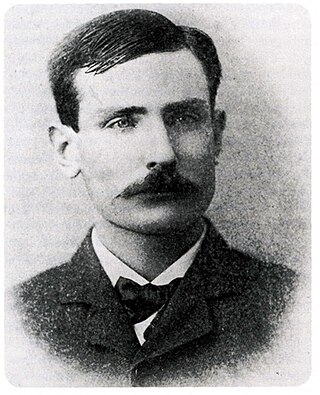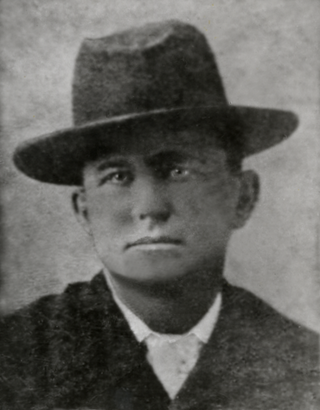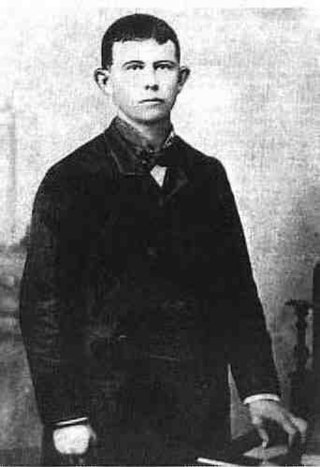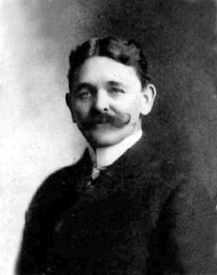
The Dalton Gang was a group of outlaws in the American Old West during 1890–1892. It was also known as The Dalton Brothers because four of its members were brothers. The gang specialized in bank and train robberies. During an attempted double bank robbery in Coffeyville, Kansas in 1892, two of the brothers and two other gang members were killed; Emmett Dalton survived, was captured, and later pleaded guilty to second-degree murder, although he later asserted that he never fired a shot during the robbery. He was paroled after serving 14 years in prison.

The Wild Bunch, also known as the Doolin–Dalton Gang, or the Oklahombres, were a gang of American outlaws based in the Indian Territory in the late 19th and early 20th centuries. They were active in Kansas, Missouri, Arkansas, and Oklahoma Territory during the 1890s—robbing banks and stores, holding up trains, and killing lawmen. They were also known as The Oklahoma Long Riders because of the long dusters that they wore.

William Doolin was an American bandit outlaw and founder of the Wild Bunch, sometimes known as the Doolin-Dalton Gang. Like the earlier Dalton Gang alone, it specialized in robbing banks, trains, and stagecoaches in Arkansas, Kansas, Indiana, and Oklahoma during the 1890s.

William Matthew Tilghman Jr. was a career lawman, gunfighter, and politician in Kansas and Oklahoma during the late 19th century. Tilghman was a Dodge City city marshal in the early 1880s and played a role in the Kansas County Seat Wars. In 1889 he moved to Oklahoma where he acquired several properties during a series of land rushes. While serving as a Deputy U.S. Marshal in Oklahoma, he gained recognition for capturing the notorious outlaw Bill Doolin and helping to track and kill the other members of Doolin's gang, which made him famous as one of Oklahoma's "Three Guardsmen".
The Three Guardsmen is the name popularized in Old West literature describing three lawmen who became legendary in their pursuit of many outlaws of the late 19th century. Deputy U.S. Marshals Bill Tilghman (1854–1924), Chris Madsen (1851–1944), and Heck Thomas (1850–1912) were "The Three Guardsmen", working under U.S. Marshal Evett "E.D." Nix.

James Patrick Masterson, was a lawman of the American West and a younger brother of gunfighters and lawmen Bat Masterson and Ed Masterson.

George "Bitter Creek" Newcomb was an American outlaw of the American Old West. He was first a member of the Dalton Gang, but after being called "too wild" by Bob Dalton, he and Bill Doolin started the Wild Bunch gang.
Rose Elizabeth Dunn also known as Rose of Cimarron and later Rose of the Cimarron, was best known for her good looks and for her romantic involvement with outlaw George "Bittercreek" Newcomb when she was a teenager during the closing years of the Old West.

Roy Daugherty, also known as Arkansas Tom Jones, was an American outlaw of the Old West, and a member of the Wild Bunch gang, led by Bill Doolin. He was the longest-lived, as well as the last surviving member of the gang.

Mason Frakes Dalton, also known as William Marion "Bill" Dalton, was an outlaw in the American Old West. He was the co-leader of the Wild Bunch gang and with his brothers Gratton, Bob and Emmett Dalton was a member of the Dalton Gang.

John Franklin Dalton was a Deputy US Marshal of the Old West under Judge Isaac Parker, for Oklahoma Territory, as well as the older brother to the members of the Dalton Gang, in addition to being the brother to William M. Dalton, once a member of California legislature, and later an outlaw and leader of the Doolin Dalton gang alongside Bill Doolin. Frank Dalton is not to be confused with J. Frank Dalton (1848-1951), who made many claims to be famous people, including his claim of being Frank Dalton, and later Jesse James.
Bill Raidler, known as "Little Bill" Raidler was an American outlaw of the Old West, and member of the Doolin-Dalton gang.

Charley Pierce was an American outlaw in the American Old West who rode with both the Dalton Gang and the Doolin Dalton Gang during the 1890s. He and "Bittercreek" Newcomb were killed by friends, the Dunn brothers, for bounty money.
The Dunn Brothers were a group of brothers from Pawnee, Oklahoma, who worked as Old West bounty hunters. They are best known for having killed George "Bittercreek" Newcomb and Charley Pierce, members of the Wild Bunch.
Oliver Yantis, known as Oliver "Ol" Yantis was an American outlaw of the Old West, best known for being a member of the Doolin Dalton Gang.

Gratton Hanley "Grat" Dalton was an American outlaw in the American Old West. He was one of three brothers in the Dalton Gang, led by his younger brother Bob Dalton. Both brothers were killed during a shootout in an ill-fated raid on two banks in Coffeyville, Kansas. Their brother Emmett Dalton survived to be convicted and imprisoned for fourteen years.

Evett Dumas Nix, often known as E.D. Nix, was a United States Marshal in the late 19th century handling the jurisdiction that included the wild Oklahoma Territory, later to be the state of Oklahoma. He was first appointed in 1893, in the closing years of the Old West, during the last years of the "Hanging Judge" Parker tenure.
The Hunnewell gunfight was an Old West gunfight occurring in Hunnewell, Kansas occurring on August 21, 1884. The gunfight involved no known gunmen.

Robert Rennick Dalton was an American outlaw in the American Old West. Beginning in 1891, he led the Dalton Gang, whose varying members included three of his brothers. They were known for robbing banks, stagecoaches and trains, primarily in Kansas and Oklahoma Territory, quickly attracting pursuit by lawmen.
Little Britches is an outlaw in the American Old West associated with Cattle Annie. Their exploits are fictionalized in the 1981 film Cattle Annie and Little Britches, directed by Lamont Johnson and starring Diane Lane as Little Britches.












